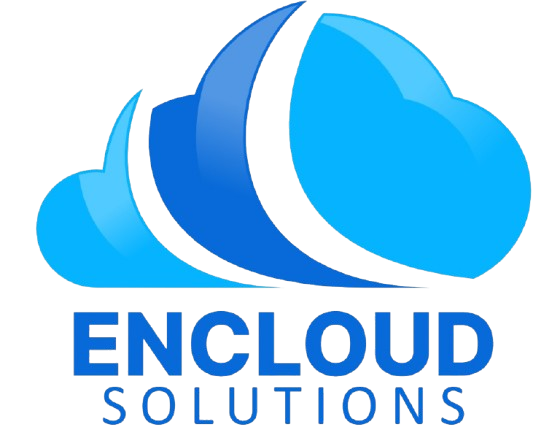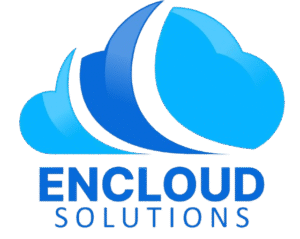
Choosing the right Enterprise Ecommerce Platform is crucial for large companies that manage extensive product catalogs, heavy traffic, and multiple sales channels. These robust software systems handle everything from high-volume transactions to complex integrations, ensuring fast checkout and a consistent customer experience. In this guide, we explain what enterprise ecommerce platforms are, why they matter, and how to pick the best one for your needs. We also compare the leading enterprise ecommerce platforms in the market, highlighting key features, benefits, and how they support rapid business growth.
What Are Enterprise Ecommerce Platforms?
An Enterprise Ecommerce Platform is a comprehensive, all-in-one software solution built for large, high-growth online businesses. Unlike small-store ecommerce tools, these platforms combine order processing, inventory and catalog management, payment handling, customer data, and analytics in a unified system. They are designed to handle massive traffic spikes, global sales, and complex product portfolios without compromising performance. In essence, an enterprise platform provides a single access point to manage every aspect of e-commerce operations at scale. As Encloud Solutions notes, leading platforms provide rich features and integrations that automate business processes end-to-end.
A modern enterprise ecommerce platform may support different architectures (monolithic vs. headless) and deployment models (on-premises, cloud, SaaS). For example, headless or API-first platforms decouple the storefront from the backend, offering maximum flexibility for custom front-end experiences. Open-source options give you full code control, while SaaS solutions relieve you of infrastructure management. No matter the style, these systems share common goals: reliability under load, rich omnichannel capabilities, and the ability to integrate with ERP, CRM, and marketing tools.
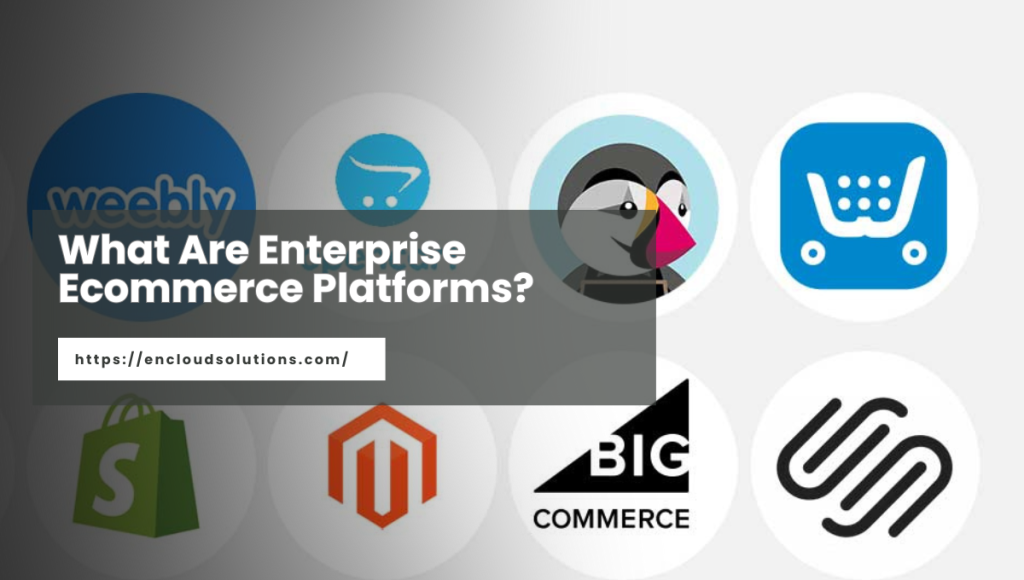
Why Large Enterprises Need a Robust Ecommerce Platform
As businesses grow, their e-commerce requirements quickly outpace what basic solutions can handle. Enterprise platforms are built to solve challenges that arise at scale:
1) High Traffic & Performance
These platforms guarantee uptime even during peak seasons. They use a distributed cloud infrastructure and optimized code so that your site stays fast when thousands of customers browse and check out. Downtime or slow pages at enterprise scale means huge lost revenue, so top platforms emphasize performance and 99.99% uptime.
2) Omni-Channel Selling
Enterprise sellers often sell on web, mobile, social, and in-store channels simultaneously. A good enterprise platform lets you manage all channels from one place. It handles things like marketplace and social media integrations, buy-online-pickup-in-store (BOPIS), and unified inventories. This omnichannel reach ensures a seamless customer experience no matter where or how people shop.
3) Complex Catalogs
Large companies may have tens of thousands of SKUs, configurable products, or global catalogs. Enterprise systems include advanced catalog management and tax rules for multiple regions. They automate complex tasks like bulk price updates, multi-language content, and tiered pricing for B2B partners.
4) Robust Security & Compliance
Protecting customer data is non-negotiable. Enterprise platforms are built with industry-standard security (SSL/TLS encryption, PCI compliance, regular audits) baked in. They keep your business safe from breaches, fraud, and data loss.
5) Full Integration
At scale, e-commerce rarely runs in isolation. These platforms offer rich APIs and pre-built connectors to ERP, CRM, marketing automation, and logistics systems. For example, they can push online orders straight into an ERP or synchronize product data across channels. This eliminates manual data entry and ensures teams in finance, logistics, and customer service all work from the same live data.
6) Personalization & Analytics
With built-in AI and analytics, enterprise platforms help you personalize marketing and optimize operations. They can recommend products, segment audiences, and report on sales trends. Every customer interaction becomes data that the system uses to improve search, promotions, and the overall user journey.
In short, migrating to an enterprise ecommerce platform equips your business with the tools needed for rapid growth. These platforms can handle peak demand without breaking, automate end-to-end processes, and support innovative features (like AR shopping or AI chat assistants) that smaller platforms can’t deliver reliably.
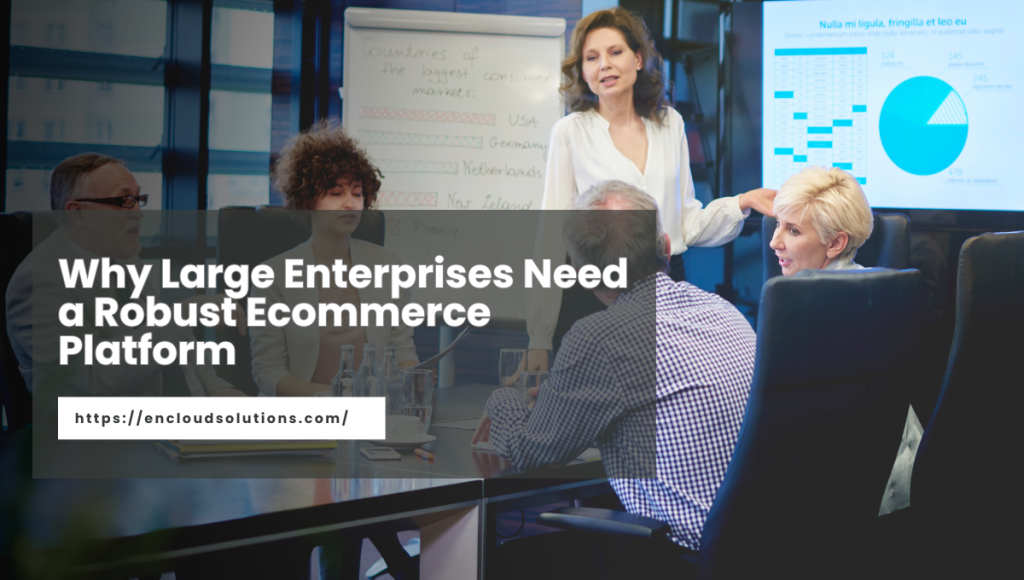
Key Features of Enterprise Ecommerce Platforms
When evaluating enterprise ecommerce platforms, look for these core capabilities:
1) Scalability
The ability to easily scale up servers and bandwidth during high-demand periods. Top platforms auto-scale in the cloud to handle traffic surges (like flash sales) without crashing.
2) Headless/Composable Commerce
Support for a headless or API-driven architecture lets you customize the frontend independently. Leading enterprise platforms provide robust REST/GraphQL APIs so you can build unique storefronts or connect to any front-end framework. This enables truly omnichannel experiences.
3) Multi-Channel Support
Native integrations for marketplaces (Amazon, eBay), social commerce, mobile apps, and physical point-of-sale (POS) systems. The platform should centralize orders and inventory across all channels.
4) Internationalization
Built-in support for multiple languages, currencies, and region-specific tax/ VAT rules. This is essential for enterprises selling globally or planning to expand internationally.
5) Advanced Catalog & Order Management
Powerful product catalogs that handle complex product types (bundles, kits, subscriptions) and enterprise-grade order management systems (OMS) to automate fulfillment workflows, track returns, and manage backorders.
6) Rich SEO & Marketing Tools
Enterprise solutions often include SEO features (customizable URLs, metadata) and marketing tools like targeted promotions, email campaigns, and loyalty programs, all easily managed from the platform.
7) Built-in Analytics & BI
Dashboards and reports that provide real-time business intelligence on sales, customer behavior, inventory levels, etc. Many platforms also integrate with BI tools or ERP systems for deeper analysis.
8) Security & Performance
As mentioned, expect enterprise-grade security (DDoS protection, web application firewalls, regular patching) and performance optimizations (CDNs, image compression, mobile caching) to deliver a seamless experience to every user.
These features ensure that the platform can support large teams (merchandisers, marketers, developers), complex processes (promotions, global shipping), and high traffic—all while giving a unified experience to the shopper.
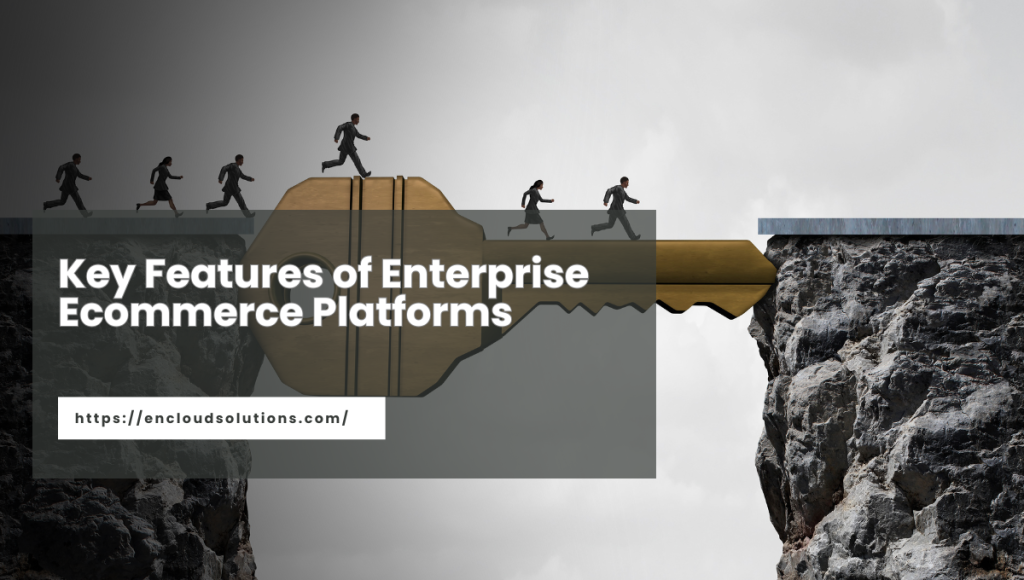
Benefits of Enterprise Ecommerce Platforms
Investing in an enterprise-level platform yields concrete business benefits:
1) Enhanced Customer Experience
Rich features like one-click checkout, product recommendations, and quick search ensure customers have a smooth journey. Enterprise software streamlines everything from inventory lookup to returns management, improving satisfaction.
2) Greater Reliability
You avoid crashes or slowdowns during peak demand. High uptime and fast page loads directly translate to higher conversion rates and more revenue. (Shopify data shows downtime can cost businesses thousands of dollars in lost sales.)
3) Omnichannel Growth
Because these platforms unify online and offline channels, you can easily expand sales through new channels. Your brand appears wherever your customers are shopping, from social media to physical kiosks.
4) Improved Security & Compliance
You no longer juggle PCI compliance or complex security configurations. Enterprise solutions handle these automatically, reducing legal risk and protecting your reputation.
5) Speed to Market
New features (holiday campaigns, new product lines, new regions) can be deployed much faster. Many platforms offer app marketplaces and low-code tools, letting you add functionality (like AR try-on or personalized upsells) without heavy development work. This agility can be a game-changer during competitive peaks.
6) Cost Efficiency at Scale
While the sticker price may be high, economies of scale kick in. Compared to managing multiple point solutions, an integrated enterprise platform often has a lower total cost of ownership. Maintenance, hosting, and licensing are bundled, and you avoid paying for redundant software licenses.
Overall, enterprise platforms pay for themselves by boosting sales and cutting inefficiencies. Businesses often see revenue growth of 10–30% after switching to a robust commerce platform, driven by better uptime, faster development, and richer customer data.
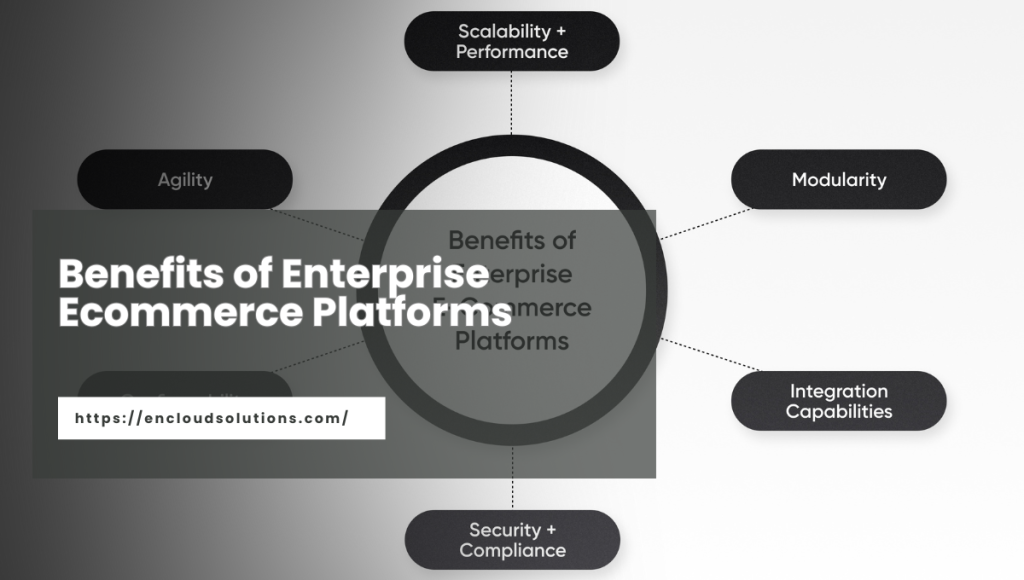
Types of Enterprise Ecommerce Solutions
Enterprise platforms vary by architecture and delivery model. Here are common types:
1) On-Premises (Self-Hosted)
The software runs on your own servers or data center. This gives you total control over code and data, but requires a large IT investment. You handle everything from updates to security. It’s flexible but expensive to maintain (studies show on-prem solutions can cost $150K–$300K+ per year in infrastructure and staff).
2) Cloud-Based / SaaS
The vendor hosts and maintains the platform in the cloud. You get the latest features without handling infrastructure or patches. This is the most common modern approach (e.g., Shopify Plus, BigCommerce). You usually pay a subscription, but you offload all technical complexity. It’s highly scalable, but customization may be more limited than on-prem.
3) Headless / Composable
This isn’t a full type, but an architectural approach. Headless platforms separate the frontend (what the customer sees) from the backend (the commerce logic). This allows brands to build custom storefronts (web, mobile app, IoT, etc.) without touching the commerce engine. Many modern enterprise solutions (Salesforce Commerce Cloud, commercetools, etc.) are built API-first for this flexibility.
4) Open-Source vs. Proprietary
Some enterprise platforms (like Adobe Commerce, WooCommerce, Magento Open Source, or Odoo with e-commerce) are open-source, meaning the source code is available. This can reduce licensing fees and allow deep customization, but you’ll still pay for enterprise-grade hosting and support. Proprietary platforms (Salesforce, SAP, Oracle) come with official vendor support and guarantees. Choose based on your team’s technical skill and need for vendor support.
The right type depends on your IT strategy: if you have strong developers and want full control, on-prem or open-source might appeal. If you prefer outsourcing maintenance and focusing on business features, a cloud/SaaS enterprise platform is usually safer for high growth.
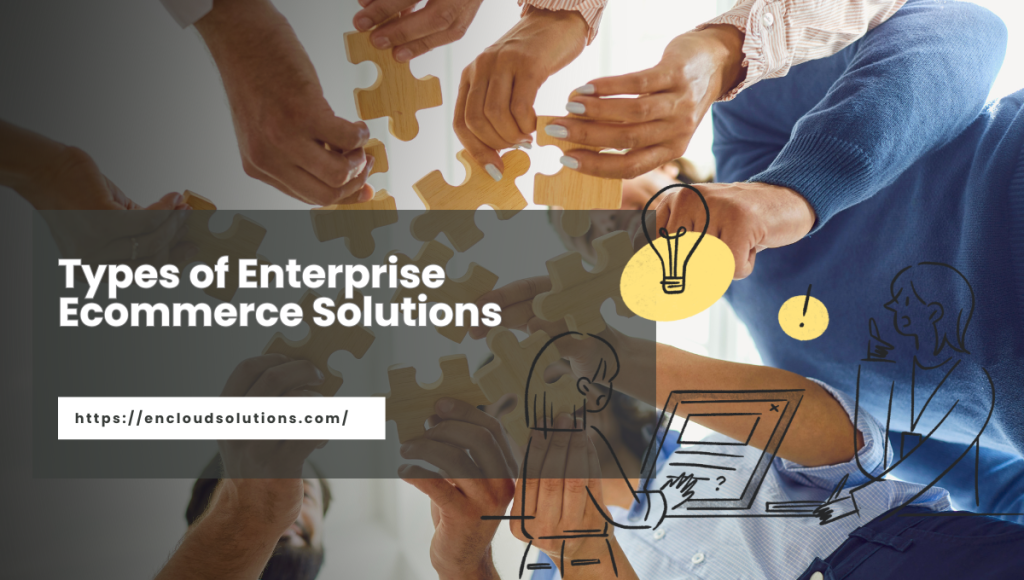
Emerging Trends in Enterprise Ecommerce
The enterprise ecommerce landscape is evolving. Here are trends savvy companies are leveraging:
1) Headless & Composable Commerce
As noted, headless architectures have exploded in popularity. Recent reports show nearly 50% of retailers had adopted headless commerce by 2022, growing to an expected ~67% by end of 2023. Gartner predicts companies using composable (modular) architectures will deploy new features 80% faster than competitors. In practice, a headless approach means your ecommerce team can test new front-end experiences or add channels (mobile app, IoT store displays) without backend redeployment.
2) Artificial Intelligence & Automation
Leading platforms embed AI for personalization, search, and analytics. Salesforce Commerce Cloud’s Einstein AI and Agentforce, for example, can auto-generate product recommendations and copy. Expect more self-service shoppers using AI chatbots and personalized marketing triggered by behavior.
3) Unified Commerce
Enterprises are breaking silos between online and offline. Technologies like real-time inventory syncing and unified customer profiles are key. According to Salesforce, companies providing a unified shopping experience (same data across channels) see about 20% higher revenue growth.
4) Mobile & Progressive Web Apps (PWA)
Mobile-first is a given, but PWAs take it further. Many enterprise sites are now PWAs for instant loading and offline features. This improves performance and user engagement on mobile devices.
5) Marketplace Integration
Some enterprises are becoming marketplaces themselves or tightly integrating with external marketplaces. Platforms like VTEX have built-in marketplace engines, and others support easy multivendor catalogs. This trend lets enterprises expand product offerings without holding inventory.
6) Sustainability & Ethical Commerce
Consumers care about social impact, so leading platforms now support features like carbon offset during checkout, or transparent supply chain traceability. Expect more reporting tools for social impact metrics in the future.
Keeping up with these trends ensures your platform investment doesn’t become outdated. Enterprise platforms that continue innovating (via ecosystem apps or native features) will give your business a competitive edge.
How to Choose the Right Enterprise Ecommerce Platform
Selecting a platform is a strategic decision. Here are the steps to guide the process:
1) Assess Business Needs
List your key requirements: expected traffic volumes, product complexity, B2B vs B2C mix, needed integrations (ERP, CRM, PIM), and specialized features (e.g., subscriptions, marketplaces). Knowing what gaps you need filled helps narrow options.
2) Consider Total Cost
Don’t just look at license fees. Estimate implementation, customization, maintenance, and hosting costs. Enterprise solutions often require large budgets (IDC reports some companies budget over $200K/year for such platforms). Plan for that scale.
3) Evaluate Technology Fit
Decide between on-prem vs. cloud, and headless vs. monolithic, based on your IT strategy. For instance, if your team is lean, a SaaS headless platform (Shopify Plus, BigCommerce) might be easier than an open-source self-hosted system.
4) Check Scalability & Performance
Research each candidate’s performance benchmarks and architecture. Ask vendors how they guarantee performance and uptime. Look for documented cases of peak traffic handling.
5) Test Integrations
If you have existing systems (e.g., ERP, PIM), ensure the platform offers connectors or APIs for seamless integration. Encloud Solutions, for example, emphasizes linking enterprise ERPs with e-commerce platforms like Shopify and WooCommerce to eliminate silos.
6) Security & Compliance
Verify their security certifications (PCI DSS, ISO 27001) and audit history. For regulated industries, find features like data residency options.
7) Vendor & Ecosystem
Consider the vendor’s track record. Read reviews (Gartner Peer Insights, etc.), check customer testimonials, and examine how active their partner ecosystem is. A large app marketplace or consulting network means more extension options and support resources.
8) User Experience & Support
Complex platforms should still be user-friendly for merchant admins. Ask for demos and a trial environment. Evaluate the vendor’s support structure (dedicated account managers, 24/7 support, user communities).
9) Roadmap & Innovation
Ensure the vendor invests in R&D. Platforms that regularly release updates (new payment methods, AI features, etc.) will keep you competitive. Salesforce being in Gartner’s MQ for 9 straight years means they continually innovate for enterprise needs.
Finally, pilot the top choices: do a small proof-of-concept or migrate a subset of your product catalog to test how each platform performs. Gathering hands-on feedback now can save a lot of rework later.
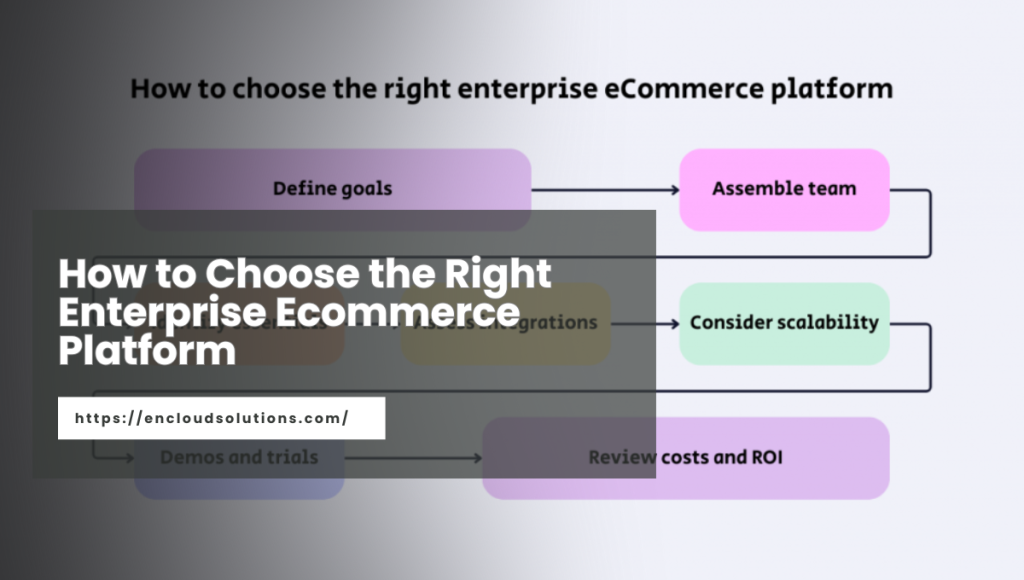
Comparison of Leading Enterprise Ecommerce Platforms
| Platform | Deployment Model | Focus | Key Strengths |
| Salesforce Commerce Cloud | SaaS (Cloud) | B2B & B2C, global omnichannel | Leader in Gartner MQ; built-in AI (Einstein) and headless APIs; unified CRM/Ecommerce. |
| Adobe Commerce (Magento) | On-premises / Cloud | B2C & B2B multichannel | Highly customizable; large community; strong B2B Suite (quote, purchase lists). |
| Shopify Plus | SaaS (Cloud) | DTC, B2C, B2B via apps | Scalable SaaS, easy to use, world-class app ecosystem; fast checkout (Shop Pay). |
| BigCommerce | SaaS (Cloud) | B2B & B2C, multi-storefronts | Open SaaS with robust REST/GraphQL APIs; headless-ready; strong SEO and multi-store support. |
| SAP Commerce Cloud | SaaS (Cloud) | B2B, B2C, B2B2C | Enterprise-grade; omnichannel focus; deep integration with SAP ERP; AI-powered personalization. |
| Oracle Commerce | SaaS (Cloud) | B2B & B2C, enterprise accounts | Cloud-native with broad enterprise features; strong data analytics; built-in promotions engine. |
| HCL Commerce | On-premises / Cloud | B2B & B2C | Scalable PWA-ready platform; excels at complex B2B pricing and promotions; robust marketing tools. |
| VTEX | SaaS (Cloud) | B2B & B2C, marketplaces | Composable, API-first; native marketplace suite; omnichannel OMS; praised by Gartner as a challenger. |
| WooCommerce Enterprise | Self-hosted (WP) | B2C (with B2B add-ons) | Open-source; powers 4M+ sites; highly customizable; massive plugin ecosystem; enterprise hosting (WordPress VIP). |
| Ultra Commerce | SaaS (Cloud) | B2C/B2B, multi-vendor markets | Cloud-native OMS/PIM with headless architecture; strong for complex catalogs and marketplace models; composable modules. |
Each platform above has its niche. For example, Salesforce and SAP shine in very large, global enterprises with heavy B2B needs, while Shopify Plus and BigCommerce excel at ease-of-use and rapid deployment for growing brands. WooCommerce (Enterprise) offers flexibility for companies comfortable with WordPress. Use this table as a starting point and dive deeper into any platform that fits your scenario.
Deep Dive: Overview of Top Platforms
1) Salesforce Commerce Cloud (SFCC)
Who Uses It: Large global brands in retail, electronics, fashion, etc. (e.g., Adidas, L’Oreal).
Key Features: Leader in Gartner’s Magic Quadrant; AI-driven personalization (Einstein), headless APIs, unified omni-channel order management. Salesforce’s Agentforce adds AI agents for merchandising and customer assistance.
Why It Stands Out: SFCC offers a unified view across sales channels and powerful built-in CRM data (via Salesforce 360). It emphasizes quick innovation – for example, it added AI-powered shopping agents and a unified B2B/B2C platform to boost sales and agility. Its cloud architecture provides 99.99% uptime, essential for large enterprises.
2) Adobe Commerce (Magento)
Who Uses It: Medium to large enterprises (e.g., HP, Liverpool).
Key Features: Once open-source (now part of Adobe), it is highly extensible for both B2C and B2B. It supports complex catalogs, multi-storefronts, and strong marketing tools (targeted promotions, content staging).
Why It Stands Out: Adobe Commerce’s flexibility is its strength: developers can customize deeply, and the platform supports headless/PWA via partners. It also benefits from Adobe’s ecosystem (integration with Adobe Experience Cloud for personalization). Enterprises choose it when they need very custom workflows and have technical resources to maintain it.
3) Shopify Plus
Who Uses It: High-growth retailers (e.g., Allbirds, Gymshark). Als,o many B2B brands via apps.
Key Features: Robust SaaS platform with nearly unlimited scale, global CDN, and the fastest checkouts (Shop Pay). Native support for multi-channel selling (web, POS, social). Shopify Plus includes an expert support team and a developer-friendly API (Storefront and Admin APIs).
Why It Stands Out: It abstracts away technical complexity. You get built-in PCI compliance and hosting, and a broad app marketplace. According to Shopify, many merchants leverage its headless capabilities and composable commerce solutions for custom experiences. For enterprises, it offers the best of both worlds: enterprise-grade performance with ease of use.
3) BigCommerce Enterprise
Who Uses It: Growing global brands (e.g., Toyota, Ben & Jerry’s). Good for both B2C and headless B2B setups.
Key Features: An open SaaS model, which means it combines hosted convenience with developer freedom. BigCommerce emphasizes robust APIs (REST/GraphQL) and strong native B2B functionality (corporate accounts, custom catalogs). It also handles multi-storefront (one backend, multiple frontends) very well.
Why It Stands Out: BigCommerce is known for its headless commerce leadership. It provides out-of-the-box integrations for front-end frameworks (React/Next.js, Vue/Nuxt.js) so that you can build any custom storefront. This makes it popular for brands that want to integrate commerce into existing CMS or custom sites without replatforming the entire backend.
4) Oracle Commerce Cloud
Who Uses It: Large B2C and B2B companies (e.g., Vodafone, Airbus). Often chosen by companies already using Oracle Cloud Suite.
Key Features: A cloud-native platform with rich out-of-the-box features. It offers powerful merchandising and marketing tools (segment routing, A/B testing) and strong business intelligence. Oracle Commerce integrates seamlessly with Oracle’s broader CX suite (marketing automation, CPQ, etc.).Why It Stands Out: Oracle’s strength is handling very complex enterprise scenarios. It can unify e-commerce with global ERP/Finance through Oracle’s ecosystem. Its flexible catalog and pricing engines make it a go-to for companies with complicated product configurations and approval workflows.
5) SAP Commerce Cloud
Who Uses It: Very large enterprises (e.g., Coca-Cola, Vodafone). Used heavily in manufacturing, retail, and distribution.
Key Features: Built for enterprise complexity: supports B2B, B2C, and B2B2C business models seamlessly. It includes advanced features like subscription management, advanced search, and cloud scalability. SAP Commerce Cloud also integrates AI personalization and comes with a PWA accelerator for modern front-ends.
Why It Stands Out: Deep integration with SAP ERP/HANA is a key differentiator. If your company already runs SAP in supply chain and finance, SAP Commerce Cloud extends that unified suite to the customer-facing side. Its modular architecture (with many industry-specific extensions) means it can handle very complex pricing and product rules.
6) HCL Commerce (formerly IBM WebSphere Commerce)
Who Uses It: Large B2B and B2C brands (e.g., BMC Software, L.L.Bean). Also used in retail with complex catalogs.
Key Features: A multi-channel platform with strong marketing, pricing, and promotions capabilities. HCL Commerce supports Progressive Web Apps and headless approaches. It is designed for scalability and offers built-in tools for merchandising and personalization.
Why It Stands Out: It excels in hybrid B2B/B2C scenarios and complex pricing engines. HCL focuses on reliability at scale and extensive global deployments. Enterprises choose it for its flexibility and maturity – it has been battle-tested by large retailers over decades.
7) VTEX
Who Uses It: Global brands and retailers (e.g., Sony, Walmart Mexico) pursuing marketplace models.
Key Features: VTEX is API-first and fully composable. It has a built-in Order Management System and a unique multi-tenant marketplace suite. It also offers headless front-end tools (VTEX IO). VTEX runs on a serverless architecture.
Why It Stands Out: VTEX blurs the line between e-commerce platform and marketplace platform. Its clients often operate multi-vendor marketplaces as well as direct sales on the same system. It is praised for rapid time-to-market and lower total cost of ownership, as well as a flexible partner ecosystem (24 industry awards from trade reports).
8) WooCommerce (Enterprise)
Who Uses It: Enterprises already committed to WordPress (e.g., Small-to-medium retailers scaling up). When paired with enterprise hosting, it can handle high traffic.
Key Features: Open-source plugin for WordPress with strong multi-channel integrations. With performance-focused hosting (WP Engine or WordPress VIP), it can scale. It supports all content capabilities of WordPress, making it great for content-rich stores.
Why It Stands Out: WooCommerce’s advantage is flexibility and ownership. You own all your data and can customize anything in PHP. It’s chosen by companies that want full control and have strong dev teams. According to industry data, it powers over 4 million sites, showing its broad use. For true enterprise use, you’d likely add paid support services or plugins to ensure SLAs.
9) Ultra Commerce
Who Uses It: Specialized enterprises (e.g., manufacturers, distributors) with complex catalog and order workflows.
Key Features: A unified commerce platform combining commerce, OMS, and PIM in one solution. It is fully API-first and built on microservices, so any part of the system scales independently. It offers rich marketplace/multi-vendor capabilities and works out-of-the-box with various ERPs.
Why It Stands Out: Ultra is designed for businesses that need heavy custom workflows (like B2B quoting, complex approvals). Its architecture is headless and composable, and it emphasizes deep integration (custom ERP modules, vendor portals). In essence, it’s an enterprise platform built by eCommerce experts (Euvic) for very specific needs.
Each of the platforms above can be the “best” depending on your specific requirements. The right choice will align with your business model (B2B vs. B2C), technical team’s skillset, and existing IT investments.
Each enterprise scenario is unique. By carefully evaluating features, costs, and future plans, you can select an enterprise ecommerce platform that accelerates growth while meeting all operational demands. With the right platform in place, your business will be equipped to scale efficiently and deliver outstanding customer experiences at any volume.
Frequently Asked Questions
What is the definition of an enterprise ecommerce platform?
An enterprise ecommerce platform is a large-scale, all-in-one ecommerce software solution for big businesses. It integrates sales channels, inventory, CRM, and more into one system. According to Shopify’s guide, it “includes an integrated suite of applications that helps merchants automate business processes and streamline their workflow,” supporting complex B2B/B2C operations.
When should a company upgrade to an enterprise ecommerce platform?
When your business outgrows basic e-commerce tools. Signs include: traffic surges causing crashes, product or price complexity that small platforms can’t handle, needing multi-channel sync (like online + retail), or requiring deep integrations (ERP, CRM, etc.). If you’re experiencing frequent feature limitations or performance issues, it’s time to move to an enterprise-level solution.
How do enterprise e-commerce platforms integrate with ERP and CRM systems?
They typically offer APIs and pre-built connectors to integrate with ERP/CRM. For example, Encloud Solutions highlights that their ERP integration services link systems like Shopify, WooCommerce, or Amazon to an ERP, eliminating silos. This means orders, customers, and inventory updates flow automatically between systems. When choosing a platform, ensure it supports seamless data exchange (often via REST APIs, webhooks, or middleware).
What role does headless commerce play in enterprise ecommerce?
Headless commerce is an increasingly important approach for enterprises. It decouples the frontend and backend, letting brands create any type of user interface (mobile app, IoT device, single-page app) on top of the same core ecommerce engine. This flexibility speeds up front-end innovation without backend rework. Industry reports show headless adoption rising sharply (over 60% of large retailers plan to implement headless by 2024). A headless-capable enterprise platform ensures future-ready agility.
Which enterprise e-commerce platform is considered the market leader?
Salesforce Commerce Cloud and Adobe Commerce are often cited as leaders for large enterprises, with Shopify Plus and BigCommerce recognized for ease of use. Notably, Salesforce has been positioned as a Leader in Gartner’s Digital Commerce Magic Quadrant for nine consecutive years, highlighting its strong execution and vision. Ultimately, the “best” platform depends on your needs. Gartner and Forrester reports, along with real user reviews, can help compare leadership positions in different categories.
How do enterprise ecommerce solutions support omnichannel growth?
These platforms treat each sales channel as part of one unified system. For instance, they can sync inventory across physical stores and online, manage orders from marketplaces, and allow customers to buy online and pick up in-store. This unified commerce approach ensures customers have a consistent experience everywhere. Salesforce notes that companies unifying commerce on every channel often see at least 20% higher revenue by 2025.
How can Encloud Solutions help with enterprise ecommerce?
As an experienced IT services firm specializing in ERP and CRM, Encloud Solutions can assist in integrating your chosen e-commerce platform with back-office systems. For example, their team has linked Odoo ERP with Shopify and WooCommerce platforms to automate order sync. They also provide customization and support services to maximize your e-commerce ROI. In short, Encloud can help tailor and connect your enterprise ecommerce system so it fits your unique processes.
What is the typical cost of an enterprise ecommerce platform?
Costs vary widely. Subscription-based SaaS platforms often charge monthly fees that scale with GMV (gross merchandise volume) or store traffic. Large-scale solutions (like Salesforce or SAP) usually require negotiation, with expenses including license fees, implementation, and ongoing support. Industry data suggests maintaining enterprise systems can exceed $150K–$300K per year for licensing and infrastructure. Budget for both initial setup and multi-year operation when planning your investment.
